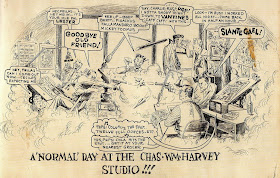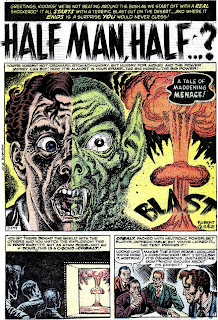
Number 602
Do two half-men make up one whole man?
I noticed the title similarity to these Atlas Comics stories, but the titles are all that's alike. "Half Man, Half...?" is from Menace #10, 1954. "Half Man" is from Uncanny Tales #22, but my scans are from the 1970s reprint in Crypt of Shadows #9.
"Half Man, Half...?" is drawn by Robert Q. Sale, a staple of the Atlas bullpen. At one time Sale shared studio space at the Charles William Harvey studios with Harvey Kurtzman, Will Elder, John Severin and Charlie Stern. This 1949 cartoon illustration by Severin is from The Art of Harvey Kurtzman, The Mad Genius of Comics by Denis Kitchen and Paul Buhle.
 Sale is seated with his back to us, and is singing along with a radio commercial.
Sale is seated with his back to us, and is singing along with a radio commercial. "Half Man" is an allegory about Jim Crow and the treatment of African-Americans in the U.S. after returning from World War II. They rightfully felt they'd be recognized for their service and given full rights as citizens. Even in 1954 when dealing with such subject matter as race, the main characters shown are white. It undercuts the point, but publishers tread a little more lightly in those days when they were scared of losing readers in areas of the country where segregation was the law.
"Half Man" is credited at the Atlas Tales website to "Fass?" which means Myron Fass, and the question mark means they aren't sure. I'm not familiar enough with Myron Fass' comic art to make a determination, but I know a bit about Fass's later life as a publisher of sleazy and exploitation magazines, including the Eerie Publications line. You can read about Myron Fass here.










**********
Say what?
I could take you more seriously if you'd stop wearing mouse ears.
 From Atomic War #3.
From Atomic War #3.





































